























































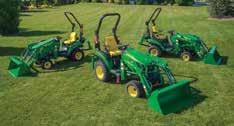


















































































































Vineland Research and Innovation Centre’s annual open house covers trees, soil and sustainability
By Luke Edwards
To the naked eye, a clump of soil is little more than a dead pile of dirt.
But to Jason Henry and Stephanie Vickers, it is - or at least should be - an entire ecosystem of life. Henry and Vickers were two of the presenters at last month’s What’s Growing On open house hosted by Vineland Research and Innovation Centre, sharing some of their expertise and explaining about the work they do to improve soil health.
“(We should be) treating our soil as a living, functioning organism,” said Vickers, a soil management specialist in horticulture with the Ontario Ministry of Agriculture, Food and Agribusiness.
“Soils are unique and diverse ecosystems.”
This year’s open house covered trees, soil and sustainability, taking visitors through three stations. Vickers and Henry, a soils research scientist, discussed the impor-


tance of keeping soil healthy and ensuring there’s enough organic material for the microbes in the soil to thrive.
Henry, with the help of a few volunteers, ran a test of four soil samples to show just how much of an effect soil maintenance can have.
The kicker? The four samples were all from the same site.
“They’re the same soil, we’ve just added life back into it,” he said.
There are several ways to add that life back into the soil. Henry outlined some lesser known soil amendments like pellets made from chicken manure, feather meal, insect manure and vermicompost (worm castings).
Vickers also discussed some of the work she’s doing with the farming community to explore the use of cover crops in vineyards and orchards. Common in other types of farming, cover crops can add organic material to the soil, control erosion and reduce compaction. Options they’ve looked at include different types of clover and alfalfa.
“Often the best option is to mix two species,” she said.
While a healthy soil provides the foundation, no one brags about


their field of dirt or a barren garden. The whole point is to provide a space for fruits, vegetables and trees to thrive.
“They didn’t understand the idea of spreading your risk,” said deJonge.
Now, species such as hackberry trees are a preferred option.
“It’s a good replacement for elm,” said Hermansen.


Publisher
Stewart Grant • stew@granthaven.com
Editor
Luke Edwards • luke@granthaven.com
Business Development
Heather Dunbar • heather@granthaven.com
Graphic Design
Erin Parsons • niagarafarmsnewspaper@gmail.com
Billing Administrator
Jen Gaetan • jen@granthaven.com
Contributor
Ann Marie Chechalk


Restoring small-town journalism, one community at a time!
Rhoda deJonge, director of plant responses and the environment, and Helen Hermansen, a restoration ecologist for Land Care Niagara, led a second station where they gave some tips on tree planting. They said the hole should be twice as wide as it is deep, shaped like a saucer and be essentially level with the root ball.
Snipping any circling roots can help the tree grow properly once in the ground, and a layer of mulch in a doughnut pattern around the tree helps.
A renewed focus on appropriate tree species has brought people back to native trees. Variety is also important, obvious to anyone who lives in an area once dominated with ash trees now destroyed by the emerald ash borer.
While deJonge recommends regularly watering a newly planted tree until it gets established, Hermansen said fertilizing them isn’t usually worth the hassle. Instead, adding some compost during planting can be all that’s needed.
“A tree has evolved to take in organic material,” she said.
Staking trees should also be done with careful consideration, as that can lead to a weakened trunk.
The open house also included a tour of the Millennium Forest, a project that saw several organizations and service clubs team up to create a three-acre plot of land on the east end of the Victoria Avenue campus that features over 100 different trees.

tally
Farmers realize they are part of the solution to a lot of things, like
By Luke Edwards
The region’s strong connection to tender fruit production will be on full display in August.
Two major peach festivals are returning to the area this month, with Winona and Niagara-on-the-Lake playing host. The NOTL festival runs Friday, Aug. 8 and Saturday, Aug. 9 in the heart of Old Town, while Winona’s festival is set for a couple weeks later, running from Friday, Aug. 22 until Sunday, Aug. 24.
Here’s what you need to know about each festival.
Bryan Gilvesy, now CEO of ALUS Canada, started his involvement with the program when he signed up as a participant to the program and then became a member of the Norfolk Partnership Advisory Committee. Bryan and wife Cathy raise Texas longhorns on the YU Ranch, south of Tillsonburg.
Niagara-on-the-Lake
Kicking off on Friday, Aug. 8 at Simcoe Park, and expanding the following day to include Queen Street, NOTL’s peach festival will feature vendors, a peach pie contest, antique tractor displays, a kids zone and more.
New this year is what organizers are calling the Peach Pit, a music hub at the Simcoe Park bandshell. Local musicians will be performing both days, starting at noon on Friday and 11 a.m. on Saturday.
Hours for the festival are noon to 7 p.m. on Friday and 10 a.m. to 6 p.m. on Saturday. Paid parking is available in the heritage district, but organizers recommend parking at Fort George and taking a free shuttle into the festival.
For more information, visit niagaraonthelake. com/peachfestival.
Winona
Up in Stoney Creek, the Winona festival kicks off at 5 p.m. on Friday, Aug. 22.
(519)
There will be a huge variety of arts and craft vendors, along with commercial vendors, as well as entertainment, food, a midway, fish pond and the Peach of a Car Show.
One of the offshoots of Norfolk’s initial efforts occurred after Prince Edward Island environment George Webster attended the pilot launch in 2008. The island was having an environmental issue at the time and Today, nationally ALUS is approaching 1,000 farmers participating
Officially, ALUS Canada’s mantra now is: “ALUS Canada makes it ardship. ALUS invests in farmers and landowners who are producing acres of clean air, clean water, wildlife habitat
Credit was given to some of the programs largest advocates by Gilvesy. Local MPP
nent since the early days, and introduced a Private Member’s Bill promoting the concept.
moting it there. Bob Sopuck, who was Delta Waterfowl’s western vice-president of policy was an early advocate and became elected as an MP and was the program’s champion on Parliament Hill. Dave Reid co-wrote the

Admission is still free, but new this year is that entry to the park will be cut off at 9:30 p.m. in an effort to improve safety.
Hours for the festival are: Friday, 5 to 11 p.m.; Saturday, 10 a.m. to 11 p.m.; and Sunday, 10 a.m. to 6 p.m.
Those who are feeling lucky can purchase tickets for a 50/50 draw either at the festival or ahead of time at various locations, including:
Over the years, Gilvesy has talked to thousands of people about ALUS at hundreds of speaking engagements across Canada. Recognition for the program has included a Premier’s Ag Innovation Award
Winona Gardens (1381 Hwy 8, at Fifty Road), Rookies Variety (1247A Hwy 8), Puddicombe Farms (1468 Hwy 8), Metro at Winona Crossing, and the Real Canadian Superstore in Grimsby.
The draw will take place as the festival wraps up, Sunday, Aug. 24 at 5:30 p.m.
Gilvesy is proud ALUS is a farmer-led program and farmers fell they are the program owners.
For more information visit winonapeach. com/information.
“People feel they are partners in ALUS,” he said. “It’s the value of developing a grassroots program that recognizes the value of community.”





































By Luke Edwards
A member of Canadian hockey royalty will be the celebrity guest speaker when this year’s Niagara Grape and Wine Festival kicks off.
In a press release issued last month the Grape Growers of Ontario announced four-time Olympic gold medalist, Hockey Hall of Fame inductee and philanthropist Hayley Wickenheiser will be the celebrity guest at the Wednesday, Sept. 17 celebrity luncheon. The luncheon acts as the kickoff to the festival, itself a celebration of Niagara’s grape and wine industry.
Debbie Zimmerman, CEO for the GGO, said it will be an honour to welcome Wickenheiser to Niagara.
“Her remarkable achievements and commitment to leadership, community, and excellence make her an inspiring addition to this year’s celebration,” Zimmerman said.
Most known for her stellar hockey career, Wickenheiser propelled the Canadian women’s hockey team to four gold medals and one silver. She’s the all-time leading scorer internationally for Canada’s national women’s team and was the first woman to register a point in a men’s professional hockey game.
She’s a first-ballot hall of famer and currently serves as the assistant general manager of player development for the Toronto Maple Leafs.
Outside hockey, Wickenheiser also competed at the Olympics in softball.

In addition to her role with the Leafs, she also practices family and emergency medicine and tours as a bestselling author and speaker.
Wickenheiser was named as one of Sports Illustrated’s “Top 25 Toughest Athletes in the World” list and twice appeared on the magazine’s “Power 50 in Sports” list. She’s a member of the Order of Canada, Canada’s Sports Hall of Fame and Canada’s Walk of Fame.
As a philanthropist, Wickenheiser founded the Canadian Tire Wickenheiser World Female Hockey Festival, which mentors young athletes from around the world. She’s also been involved with, and a supporter of, groups like Right to Play, Jumpstart, Project North and KidSport.
Meridian Credit Union is the primary sponsor for the luncheon.





“This event is a cherished tradition that celebrates the dedication and innovation of Ontario’s grape growers and the vibrant communities they support. Our continued partnership reflects Meridian’s commitment to fostering growth and prosperity in the agri-food sector and across the province,” said Stephen Otten, regional vice-president for business banking at Meridian.
The luncheon is on Wednesday, Sept. 17, at 11:30 a.m. at Club Roma in St. Catharines. Ticket order forms are available at grapegrowersofontario.com or by contacting the GGO Board office at (905) 688-0990 or info@grapegrowersofontario.com.
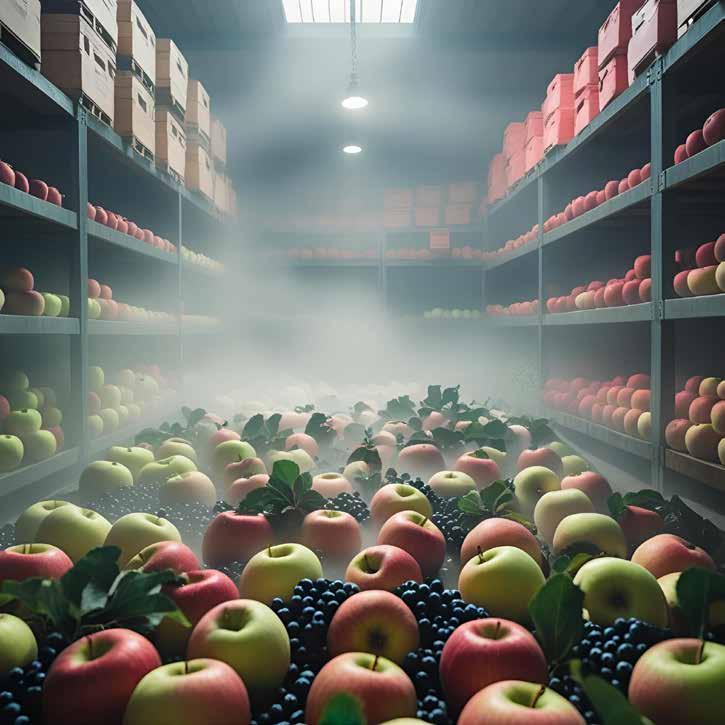



By Niagara Farms Staff
The spotlight will shine on the province’s ag sector later this year when the 2025 Excellence in Agriculture Award winners are announced, but first they require nominees.
Ontario’s Ministry of Agriculture, Food and Agribusiness has opened nominations for the annual awards, with the public having their chance to put forward a deserving industry member. The nomination period closes on Sept. 2.
“The Excellence in Agriculture Awards provide an opportunity to honour and celebrate our agri-food leaders,” said Trevor Jones, minister of agriculture, food and agribusiness, in a press release. “Ontario’s world-class agri-food leadership and talent are what gives us the edge in a competitive global environment, and we look forward to recognizing their innovation and success.”
There are 12 categories open for nominations in this year’s awards, including: youth, food processing, research and innovation, northern business, workforce, women, education, supply chain, Indigenous/Metis/Inuit-owned business or community, promotional, farm family, and urban agriculture.
Niagara was well represented in last year’s awards. Brock University’s Cool Climate Oenology and Viticulture Institute won the research and innovation award with Vineland Research and Innovation Centre’s David Liscombe receiving an honorable mention.




ucation category. And CareesNow! Food and Beverage Ontario received an honorable mention in the workforce category.
The awards seek to honour farmers, food processors, businesses and industry organizations that are driving excellence, sustainability



and long-term competitiveness in Ontario’s $51 billion agri-food industry, the press release said. Those looking to nominate a person or business can visit ontario.ca/agrifoodinnovation for more details. Self-nominations will also be accepted. The deadline is Sept. 2.



By Niagara Farms Staff
While many may still be in full summer mode, before you know it fall will be knocking at the door.
On the bright side, that means plenty of fall fair fun in Niagara and Haldimand. This year promises to be even busier than usual, as the International Plowing Match also makes a stop in Niagara.
Here’s a rundown of the fall fairs coming to the region.
West Niagara Fair - Friday, Sept. 5 to Sunday, Sept. 7
Grassie will be a hive of activity in September, as the West Niagara Fair leads straight into IPM 2025.
Agricultural displays, livestock shows, a midway, food and family entertainment all return for this year’s West Niagara Fair.
Homecraft entries can be submitted either online or in person through August with details on how to enter to be posted at westniagarafair. ca on Aug. 1. Keep an eye on the website for updated livestock prize book details as well.
The West Niagara Fairgrounds is located at 7402 Mud St. West.
Binbrook Fall Fair - Thursday, Sept. 11 to Sunday, Sept. 14
The 172nd running of the Binbrook Fall Fair starts off with its community appreciation night on Thursday, Sept. 11 from 5 to 9 p.m, when entry is free and rides cost $2.
It gets underway in earnest the following day, running throughout the weekend. The main grandstands will feature demolition derbies on Friday and Saturday night, as well as the kids and Dodge RAM Rodeo beginning at 10:30 a.m. and noon, respectively on Saturday and Sunday.
Live music will take place throughout, along with various kids entertainment.
Horse, cattle, and sheep and goat shows will occur throughout the day on Saturday and Sunday.
Early bird tickets are available until the end of August. For more details, visit binbrookfair.org.
The Binbrook Fairgrounds are located at 2600 Regional Rd. 56.
Wainfleet Fall Fair - Thursday, Sept. 18 to Saturday, Sept. 20
They’ve got a good thing growing in Wainfleet.


The fair’s exhibitor handbook is available online at wainfleetfallfair.com, along with other details on the fair. It takes place in the village, at 31943 Park St.
Ancaster Fall Fair - Thursday, Sept. 18 to Sunday, Sept. 21
Celebrating 175 years in 2025, Ancaster’s fall fair kicks off on Sept. 18 with some evening fun before three full days of activity.
Those with a competitive spirit can test their mettle with the hot sauce eating competition or demolition derby. For those looking for something a little less risky, there’s also a pie eating competition and baby show.
Various livestock and homecraft exhibits will also be shown, and the weekend will be full of music and entertainment.
For more information visit ancasterfair.ca. The fairgrounds are located at 630 Trinity Rd. South, Jerseyville.
Caledonia Fair - Thursday, Sept. 25 to Sunday, Sept. 28
The fair tour wraps up in Caledonia, with that community hosting its annual fall fair from Sept. 25-28.
With four days of entertainment, food, competition and more, there promises to be fun for everyone at the fair.
Caledonia’s fairgrounds is located at 151 Caithness St. East. For more information visit caledoniafair.ca.
Other festival fun
Those looking for something to do that’s on the ag or rural side of things can also keep an eye out for the Marshville Heritage Festival in Wainfleet on Labour Day, the aforementioned IPM in Grassie, or later on, the Ball’s Falls Thanksgiving harvest festival on Thanksgiving weekend in October.

That’s the theme of this year’s Wainfleet Fall Fair, which returns Sept. 18-20. With a wide mix of exhibits that should pique the interest of visitors of all kinds.




















Heritage display expected to include several local pieces of antique equipment
By Luke Edwards
At 84 years old, it sometimes takes a little help to get going.
But like any well made piece of machinery, the 1941 John Deere tractor on the Bucknall farm was built to last. And once it got going, Jim Bucknall climbed up to take it and a Massey Harris binder for a spin.
“It’s close to my age,” the 87-year-old joked.
In preparation of the upcoming International Plowing Match that will be hosted in Niagara for the first time in a century, the Bucknalls will be contributing some history to the event. Last month they took the tractor and binder out to cut and bind some wheat that will be a part of displays at the match alongside a collection of antique equipment.
“We just like to keep the history alive,” said Bucknall’s son Shelby, who’s in the process of taking over the farm from Jim.
The Bucknalls have a healthy collection of antique equipment, including the binder that Jim found on Manitoulin Island more than three decades ago. At the time he was trucking and had heard someone up that way had an old binder from the 1920s or 1930s. So when he was doing a run nearby he arranged to stop in for a look.
It turned out the binder was in pretty good shape.


“It hadn’t had a lot of abuse,” Jim said.
He brought it back to Beamsville and with a little effort got it cleaned up and in working order.
The plan now is to have it as part of a heritage display at the IPM, along with other items like a thresher, a couple steam engines, hay press, and grain grinder.
“We’re hoping to make it a pretty respectable heritage display,” Jim said.
While at the event, provided the weather cooperates, visitors will be able to watch some of the equipment in action with short demos running throughout.
Last month, with Jim on the tractor and Shelby operating the binder, the father-and-son-duo got a couple wagon loads of wheat cut and







binded. Jim said the crop was looking good this year and the binder got the job done.
The 2025 IPM takes place Tuesday, Sept. 16 to Saturday, Sept. 20. Featuring an international collection of competitive plowmen, the plowing takes place at farms around West Niagara while the West Niagara Fairgrounds will be ground zero for tent city and the wide variety of rural expo events, such as the heritage display.
Information on tickets and volunteer opportunities can be found at plowingmatch.org/ ipm2025. The local organizing committee is also running a couple of fundraisers including selling benches and cookbooks. There’s also a beautification contest being run to generate interest in the event.






By Niagara Farms Staff
As Niagara prepares to host its first International Plowing Match in a century, West Lincoln’s mayor is hoping her regional colleagues will make it a warm, and lovely, welcome to the thousands of visitors.
Cheryl Ganann issued a challenge to her fellow Niagara mayors, as well as regional chair Jim Bradley, to take part in the beautification contest the local host committee is organizing.
“West Lincoln is proud to be the host municipality for this historic event,” said Ganann in a press release. “As we prepare to welcome the world to our region, I’m calling on all of my colleagues and friends to dig in, quite literally, and help us show off everything rural Niagara has to offer. Let’s put our best foot
forward as hosts and neighbours and make Niagara shine!”
The plowing match runs from Sept. 16 to 20, at the West Niagara Fairgrounds and surrounding area.
The beautification competition is open to all individuals, families, businesses and community organizations. Ganann is hoping local municipalities will also take up the call. Participants are asked to create a roadside garden display, using the IPM logo, the theme colours of green and purple, as well as their own creativity. There are first, second and third place prizes up for grabs for each category, ranging from $100 to $300.
Submissions will be accepted until Aug. 25.
Visit plowingmatch.org/ ipm2025 for more details on the event.
By Niagara Farms Staff
Picking stones will take on a different meaning early next year when an Ontario farm organization takes over title sponsorship of a major provincial curling event.
Farm & Food Care Ontario announced last month that it will be the title sponsor for the 2026 men’s and women’s Curling Ontario Provincial Championships. The competitions are set to take place in January at the Elmira and District Curling Club.
“We’re proud to partner with Curling Ontario and the host Elmira & District Curling Club in supporting this exciting championship. It’s a fantastic opportunity to share Ontario’s farm story and foster community engagement,” said Janelle Cardiff, Farm & Food Care Ontario board chair.
Top curling teams from the province will compete in the championships to see who will become
the Ontario representatives at the Montana’s Brier and Scotties Tournament of Hearts.
As part of the sponsorship, FFCO will provide financial support, in-kind event enhancements, community engagement activities, and promotional collaborations. These efforts include local food initiatives, educational programming, giveaways, and interactive opportunities for the community during the championship week.
“This is a true partnership with the Elmira community at its core. We’re thrilled to be part of an event that showcases both top-level curling and the vital agricultural sector of Ontario,” said Bill Barr, host chair of the Elmira event.
Curling Ontario chair Matt Allen said the support “will help us elevate the experience for athletes, fans, and the broader community, creating a memorable week in Elmira.”















By Luke Edwards
Easy roasting makes for easy drinking.
Matthew Torres says there’s no need to drown his family’s coffee with milk or sugar, like many Canadians stuck on their double double fix. That’s because Delicious All Day Coffee knows that sometimes less is more.
“It’s very smooth tasting coffee, low in bitterness and it’s really low in acidity so it doesn’t give people acid reflux. It all has notes of chocolate and sugarcane,” said Torres, whose parents Adriana Hurtado and Wilson Torres started the business eight years ago..
The reason for the chocolate and sugarcane notes, he added, is that the coffee plants are grown on his uncle’s farm in Colombia, beneath the shade of plantain, avocado and cacao trees.
“So that’s where it gets its natural sweetness from,” he said.
The family has been importing their coffee and selling it locally for about eight years. They offer fully organic certified coffee as well as a few products that are in the process of becoming certified. Customers can buy whole or ground beans, in medium, dark or espresso roast.
Roasting the beans is a delicate process, and Torres said many of the brands Canadians get have beans that have been roasted too much, leading to bitterness that needs to be masked with sweeteners or milk and cream.
However, Torres said their process is more careful, eliminating that bitterness that can crop up. Gentleness is key when harvesting the beans, which is why Torres said they’re handpicked by women, whose fine motor skills and dexterity are well suited to the task.

From there, the beans are sun dried before roasting, which is done on the farm.
“It’s definitely more on the mild side, but it’s very sweet. It goes down almost like tea. So we’re very proud of that,” Torres said. The result is that many coffee drinkers who are used to adding something to their coffee, can drink the Delicious All Day offerings black.
Earlier this year their farm finished second place in the fourth edition of the “Taza de Café” competition in El Peñol, Antioquia, a tourist region near the city of Medellin. It’s a big coffee area, so the second place finish was quite an achievement.
“We were super thrilled about that,” Torres said.
Delicious All Day Coffee can be found at the Grimsby Farmers’ Market each week. Torres and his parents can also be found at festivals and events throughout the province. Personally, Torres said the experience has been an amazing opportunity to see all the small towns in Ontario he didn’t even know existed. And as an introvert, it’s helped him come out of his shell and interact with friendly customers.
They also offer free delivery in Niagara through their website, deliciousalldaycoffee. com. They can also be found on Facebook and Instagram.
By Michelle Seaborn
Have you been to a farmers market in the past few weeks? Tables are overflowing with all that Niagara has to offer.
The season has shifted into overdrive, bringing us a wonderful selection of fruit and vegetables. Were you surprised to see sweet corn at the market in mid-July? How about sweet and sour cherries?
If you are craving the sweetness of cherries, get them while you can, they are here for a short time only. The sweet cherry crop is very good in the Niagara area despite the lack of rain in many centres. Sour cherries appear a bit smaller, however they are still full of flavour if jams and cherry pie is your plan.
Raspberries are sweet, and there are several different varieties available that include
yellow and purple along with the traditional red. Plums are just getting started, several varieties have already made an appearance at markets. Peaches and nectarines as well as apricots are also seen on many market tables. If you are lucky enough to find vendors with ever-bearing strawberries, you will find them flavourful and firm.
Blueberries and blackberries round out the tables with colour and variety. We won’t see apples or pears for a few more weeks, but with so much to choose from, we won’t mind waiting a bit.
Sweet corn and new crop potatoes are a favourite at the markets right now. White, yellow and bi-coloured corn will be plentiful for several weeks as well as the new crop potatoes. Both

are just waiting for a bit of salt or butter for a wonderful addition to any summer meal.
Field tomatoes and cucumbers haven’t quite made it to market yet, but by the time you are reading this, the first should be at markets throughout Niagara. Peas are almost finished but beans will take up their space and be joined by cauliflower, broccoli, onions and carrots. We are fortunate that some of these vegetables will now continue right into the late summer and early fall. Most will be vegetables that overwinter well or easy to freeze.
What a great time of year! Lovely weather and a great time to be shopping for all the freshness of farmers’ markets where everything is a product of Canada!
Michelle Seaborn is the Grimsby Farmers Market manager

Jason Young started business a few years ago, and opened a bricks and mortar store this spring
By Luke Edwards
Awards are nice, but there may be one kind of recognition that’s even more special for Jason Young.
And that’s when one of his creations sends a shockwave of nostalgia through a customer.
“Buttertarts are very nostalgic. And people, when they have them, we’ve heard many times ‘it’s like grandma used to make or it’s like mom used to make or what we got when we were kids.’ And that’s probably one of the biggest compliments for me, if people can say that about our tarts,” said the owner of The Buttertart Shack.
In fact, Young’s love of buttertarts goes back to his own grandma, who typically baked three things: apple pie, lemon tarts and buttertarts.
“I always had buttertarts on Sundays when I went to my grandma’s,” Young recalled.
“That kind of stuck with me for a long time.”
As he got older, Young entered the culinary world and became a trained chef. While it’s a job he loved, the grind of late nights and long hours can be tough. Looking around, Young realized that Ontarians really love buttertarts, so he started a side hustle making his own. It quickly grew to the point where he could leave the chef world to focus exclusively on buttertarts.
He’s been doing that for a couple years now, touring around to dozens of communities each summer to take part in buttertart festivals, including what he calls the Super Bowl of festivals in Midland each June.
In April he opened a bricks and mortar store on Main Street East in Port Colborne at the Wellington Street intersection. He already has plans to franchise, eyeing a location in northern St. Catharines to serve the rest of the Niagara region before moving beyond Niagara.


Young said quality ingredients are the foundation for a solid buttertart. He uses maple syrup from nearby White Meadow Farms and creates a traditional pie crust using real butter.
He’s also creative. Whether at festivals, in the shop or at any of the farmers markets he frequents, visitors can always expect classic buttertarts. However, those more venturous can look towards one or two of his more than 70 cre ations. During a recent stop at the Grimsby Farmers Market he had everything from cinnamon bun to raspberry coconut.
“I try to be pretty experimental,” he said.
In August he’ll be paying hom age to peach country with tarts that utilize the stone fruit. Young said the peach tarts are a popular one.
His funkiest creation is a hot honey habanero tart that uses a hot honey sauce from a local pro ducer.
Young said he’s always on the lookout for some new creation, and having the bounty of Niagara produce at his disposal each sum mer helps the creativity flow.

The shack is open Thursday to Sunday. Hours run 10 a.m. to 5 p.m. Thursday, 10 a.m. to 7 p.m. on Friday and Saturday, and noon to 5 p.m. on Sunday. He can also be found at farmers markets in Dunnville on Tuesdays, Grimsby on Thursdays and Port Colborne on Fridays.
For more information, follow The Buttertart Shack on Facebook, or on Instagram with the handle @ buttertartshack.

The Drought Protecting, Disease Suppressing, Fungicide Boosting, Frost Shielding, element your crops are missing

Timepiece was traded to Andy Veenstra’s grandfather in exchange for food during period of mass starvation known as the Hunger Winter
By Luke Edwards
In a small case in the living room of Andy and Dorothy Veenstra there’s a gold pocket watch with a special inscription referencing AC Schroot.
Nobody in the family knows who AC Schroot was, and it’s been that way since they acquired the timepiece.
And yet, the watch has been a special keepsake for the Sherkston family for decades. But soon, it’ll be returning to the descendents of the mysterious AC Schroot, who may be able to shed some light on who he was.
For years the only thing the Veenstras knew about AC Schroot was his birthday, Feb. 9, 1891, and the date of his death, Oct. 24, 1918. It ended up in the hands of the Veenstras during the desperate period in The Netherlands known
as the Hunger Winter as 1944 turned over to 1945 and the Second World War carried on. The period of starvation affected millions and killed as many as 22,000.
Much like his grandson today, Anne (the Dutch version of Andy) Veenstra was a farmer. Since they’d continue to need food, when the Nazis invaded they allowed farmers like Anne to continue their work, taking much of the produce for themselves. As winter 1944 came, starvation was rampant and people would come to farms like the Veenstras to see if they could find anything to eat, trading whatever they could for a meal.
“Everything was bartered,” Andy said.
His grandfather traded some food for the mysterious gold watch. When he died, Andy’s father Gerben took possession of it. Gerben’s family, with young Andy in tow, immigrated to Canada in the early 1950s.
It eventually ended up with Andy after Gerben died.

“We put it away and never thought of it anymore,” recalled Andy’s wife, Dorothy. In time they would put it on display in their home, in a small case one of their children got for them. It was crafted by a Swiss company called Alpina Watch Company and includes the custom inscription on the back that includes a name and two dates, presumably the date when AC Schroot was born and when he died.

“It’s quite an intricate watch,” said Andy.
Eventually curiosity took over and Dorothy began searching on the Internet to see if there were any descendents of this AC Schroot. The couple wasn’t sure what they wanted to do with the watch and after discussing it with the family decided it belonged back in the Schroot family hands, if that were possible.
It took some effort but eventually Dorothy connected with Harry and Marijke Schroot, who now live in Belgium and as luck would have it had a family tree that showed their connection to AC Schroot.
They’ve planned a visit for later
They hope to be able to learn a bit more about the family, and who this AC Schroot was and why there was a watch made with the inscription of his name, birthday and date of death.
Was he someone prominent? His death was during the waning days of the First World War, so was he somehow involved in combat?
“Maybe he did some heroic deed,” Dorothy speculated.
A search by Alpina, which still operates and makes watches to this day, turned up nothing, though the customer service department at Alpina Canada acknowledged it’s difficult to identify vintage timepieces like the one in question.



Regardless, Andy said giving it
“It’s nice that it’s going back to

By Niagara Farms Staff
Young 4-Hers have only a few days left to submit their applications for the 2025 Tricia Vaughan scholarship.
The deadline for applications is Aug. 15. Three prizes are up for grabs, ranging from $250 to $1,000.
Handed out yearly since 2007, the program aims to promote the importance of higher education, and is open to 4-H members who have completed at least six projects and are enrolled in a recognized postsecondary education program.
“Thank you to the West Niagara Fair for the scholarship last year, I really appreciated it,” said Simon Heeringa in a social media post shared by the West Niagara Agricultural Society.
“The award has gone to furthering my education at Ridgetown College. It was an honour to receive this scholarship and I want to thank you from the bottom of my heart.”
Applicants must submit a copy of their academic report cards of their last year of secondary school, a list of their extra-curricular activities, their completed 4-H clubs, involvement in the community and a brief essay discussing their personal goals.
In-person interviews may also be required.
For more information. including rules and regulations as well as application forms, visit westniagarafair.ca/ site/scholarship-program.
Program helps farmers implement energy efficiency projects
By Niagara Farms Staff
As much as $3 million will be up for grabs for Ontario farmers looking to make their operations more energy efficient.
The third intake for the Agricultural Stewardship Initiative will open up on Aug. 13, remaining available until Sept. 3. A joint effort between the provincial and federal governments, and delivered by the Ontario Soil and Crop Improvement Association, it offers between $10,000 and $90,000 for energy efficiency projects. These can include plans such as installing geothermal heating, or adopting high efficiency motor, ventilation, heating, cooling, grain drying or lighting systems.
“Farmers are true stewards of the land,” said Heath MacDonald, federal minister of agriculture and agri-Food. “With this latest round of funding, farmers across Ontario will be able to invest in greener, more efficient equipment, keeping their farms strong and sustainable for the future.”
Previous intakes have supported a total of 870 projects, to the tune of $12.5 million, since 2023.
“The Agricultural Stewardship Initiative is helping our farmers make their businesses more efficient and boosting the long-term competitiveness of the sector to withstand the current economic uncertainty and what-
ever else comes our way,” said Trevor Jones, Ontario minister of agriculture, food and agribusiness.
Jones said the third round of funding has the potential to support hundreds more farm families as they prepare for the future.
Details on eligibility and on how to apply can be found on the OSCIA website, ontariosoilcrop.org/agriculture-stewardship-initiative.
“The opportunities offered under the Agricultural Stewardship Initiative will support producers in understanding how much energy is used on their farms, and in implementing energy efficiency improvements that can reduce electrical and fossil fuel use and the rising costs of agricultural production,” said Eleanor Renaud, Ontario Soil and Crop Improvement Association (OSCIA) president. “The initiative’s objectives align with OSCIA’s mission to support farmers with knowledge, programs and community to facilitate responsible economic management of soil, water, air and crops through development and communication of innovative farming practices. OSCIA is pleased to deliver this opportunity to Ontario farmers.”
The program is funded through the Canadian Agricultural Partnership, a five-year, $3.5-billion investment by federal, provincial and territorial governments. The cost sharing formula sees the federal government provide 60 per cent of funding, and the province provide the remaining 40 per cent for programs designed and delivered by the province.”





Wainfleet dealership began as a service station a quarter century before Japanese company expanded
By Luke Edwards
One of Canada’s longest serving Kubota dealerships was already laying down roots in the Niagara agriculture community when the Japanese manufacturer entered the Great White North a half century ago.
In fact, the company that became Berg Equipment was already more than 25 years old when Kubota expanded into the Canadian market. It was started by Ben Berg (one of several Bens in the family) as a service station.
“At the time we weren’t even a tractor dealership or even in the agricultural sector at all,” said Brandon Berg, general manager at Berg Equipment whose great grandfather Ben started the business.
“He started a service station, a White Rose gas station, auto and truck repair.”
It was the founder’s son - another Ben - who began selling tractors on the side.
Then, in 1975 Kubota decided to enter Canada, setting up business here. Two years later Berg Equipment began carrying the brand, with the Bergs seeing the

smaller tractors filling a needed gap in Niagara.
“The compact tractor wasn’t really a thing. There were field working tractors and Kubota was kind of a new product segment,” Berg said.
“Even my grandfather wasn’t sold on it at the beginning. He was

like, ‘what is this little Japanese thing?’”
What the brand offered at the time wouldn’t work for the larger farm operations, but could be suited for smaller estates, hobby farms and the like.
“A little four-wheel-drive tractor was kind of revolutionary in a way,” Berg said, adding it seemed to fit the Niagara area.
Kubota was just one of several brands the company sold. It took years before Kubota became the main product line for Berg Equipment. That came as the result of a couple factors, including a general trend in the industry but also Kubota’s growing line of equipment.
Both the brand and the dealership survived through the 1980s farm crisis period, as the ag sector underwent upheaval.
“One thing that kind of stayed consistent during that time was Kubota. They were owned by a Canadian company, which is unique,” Berg said.
In many cases when it comes to large multinational companies, a dealer like Berg Equipment might
have to deal with a third-party distributor or be a small part of a larger North American organization that tends to focus its attention on the United States.
“(Canada) kind of plays second fiddle to the U.S. dealers and dealer network. But Kubota Canada has always been its own independent company that deals directly with Kubota in Japan,” Berg said.
That relationship has become extra important in the current economic and political climate, as Berg said they’re fortunate to have a Canadian distributor and direct connection to their Japanese counterparts.
With more than 75 years in business overall, and nearly 50 years with Kubota, the Bergs have plenty of institutional knowledge. Brandon’s brother, yet another Ben, is involved more on the back end service and inventory side.
Berg remembers becoming involved quite early, sweeping the floors and helping out as a 10-yearold. Having that multi-generational commitment gives Berg a sense of
Continued on page A17

community and a feeling that he’s more a steward of the business than anything else.
But they also rely heavily on a well trained and knowledgeable team. With a much broader line of equipment and customers who have a varied set of needs, Berg said he still marvels at how employees at the dealershipmany who have worked there for decades - are able to answer any question thrown their way.
“Just how knowledgeable our staff have to be to deliver a good experience to our customers,” he said.
Today, Berg serves a wide customer base, including everyone from homeowners with larger properties, to small farms or hobby farms to municipalities.
Expansion plans faced a familiar challenge in the face of the COVID-19 pandemic, but a new 28,000-square-foot space on Highway 3 opened up in 2021. Berg said the expansion was needed and the plan is to have it serve their needs and the needs of the community for the next 50 to 75 years.
They also try to be a part of the community by supporting things
like Wainfleet Minor Hockey and local charities and fundraisers like the Polo for Health event the nearby polo club organizes for the Niagara Children’s Foundation.
In a press release celebrating the 50th anniversary of Kubota Canada, company president Yannick Montagano said innovation and responding to customers’ needs is what has led to the success of the Canadian arm of Kubota.
“When we launched in Canada 50 years ago, our goal was to sell compact agricultural tractors to Canadians. Since then, we have significantly expanded our award-winning product line-up to meet the evolving needs of a broad range of markets and individuals,” Montagano said.
In 2013 the company launched a heavy equipment cold weather testing facility in Timmins, a first of its kind facility to make sure Kubota machinery works in the real-world conditions of Canada.
“We became industry leaders by listening to our customers, addressing their needs, and continuously looking towards the future,” Montagano said.
Berg Equipment is located at 42134 Hwy. 3 in Wainfleet. For more information visit bergequipment.ca.
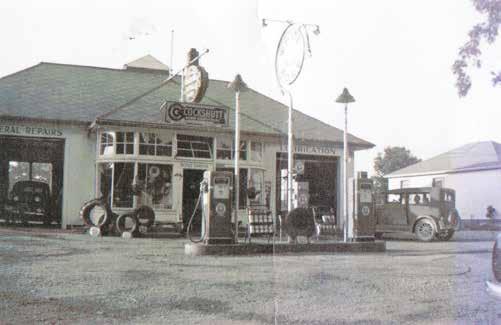





By Luke Edwards
Though he left the family farm to go on to pursue other things, Mark Carreiro never forgot the importance of understanding where our food comes from.
So with Arla, 2, and Darian, 5, in tow, the Welland man took his two kids through the barn at Krestlink Holsteins, when the Wielink family opened up the property for the annual Dinner on the Dairy event last month.
“It’s important that they start seeing the process,” he said, shortly after the family got up close with a few of the Wielinks’ calves.
Dinner on the Dairy is an annual event organized by the Niagara Milk Producers. It sees a local dairy farm open their doors for tours, answer questions and give the public a chance to see what a working farm looks like while having some fun as well. It also gives the industry a chance to remind the public of its importance. The dairy industry contributes $9 billion to Ontario’s GDP, Keith Wielink said.
“(It) lets the public see that we are still here, we’re still working hard, we’re trying to produce a good quality product for them,” said Wielink, who purchased the property off the Bartels six years ago.
At the time he was farming pigs and turkeys, though Keith grew up in the dairy industry. His sons, Lukas and Tristan, were the catalysts to get them back into dairy. In his mid-40s, Keith wasn’t sure about making the switch, but his boys were persistent. Then, the Wellandport property came up for sale.
“This opportunity came up so we jumped on it,” Keith said.
Now they raise about 70 dairy cattle, mostly Holsteins. They grow all their own feed, farming 125 acres on the main property, another 100 on a second property, as well as land they rent to add some cash cropping as supplemental revenue.
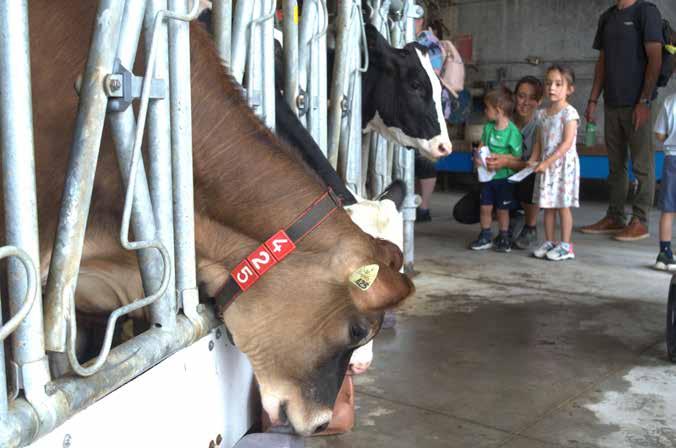
“And Keith likes the red and white ones, just because they have attitude, they’re this thing,” his wife Suzanne said with a laugh.
Dairy farming in the 2020s is a far cry from what Keith grew up around. When they moved here they installed a Lely robotics system, including a feed system and milking system. The robots don’t necessarily make for less labour for the Wielinks, but it does have a significant benefit.
“We probably spend just as much time with the cattle than if we were with a parlour but it gives us so much more flexibility,” Keith said.
Keith said the move came with a sharp learning curve. Having grown up in dairy, Keith knew more or less what to expect. For his kids, and Suzanne, though, it was all new.
“They liked the idea, they thought it was great, and now they’re all on board, but the

first few years it was a learning curve for them,” Keith said.
Even with robotics helping them out, dairy farmers still have to put the farm and the animals first, Keith said.
“You can have the best laid out plans but if a cow gets sick or something breaks in the barn, you’re here. So plans get dropped,” he said.
However, with the transition complete, Keith said they’ve got a good system going, with everyone chipping in. Suzanne runs a tight ship in the barn, keeping things neat and tidy. She also plays a big role in raising the calves, Keith said.
“I definitely see that she shines in that better than I do, and better than my boys do,” he said.
“We’re all a team, and we all have our spots.”
Even the Bartels remain involved, helping the Wielinks out with everything from haying to grabbing a morning coffee.
“They’re like family to us,” said Keith.
During the tours, volunteers took small groups of visitors through the barn where they learned about the breeds - Holsteins produce more milk but Jerseys offer higher butterfat contents - as well as all the work that goes into ensuring the cattle are fed the right total mixed ration. They also got to feed some calves before watching the robotic milker in action.
From there the visitors could head out for a meal from the Niagara 4-H food booth, play games or sit and relax.
For Keith and his family, the day turned out well, even if the time leading up to it was hectic.
“The day is actually really pretty good, I would say the three weeks before have been a little crazy,” he said. In addition to the regular chores, all the little things in preparation of the event add up.
However, Keith said it’s all worth it since it gives the family a chance to share their passion with the public. While it’s a free event, tickets are required to keep numbers manageable. The 2,200 tickets were claimed soon after they were made available.
“We love doing this, we love being farmers, we love producing milk,” said Keith.



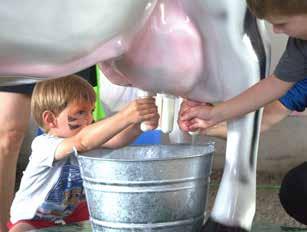




Peach Cocktail Slushy
Ingredients
• 4 to 5 Ontario peaches or nectarines, pitted (about 1-1/4 lb/625 g)
• 1/2 cup (125 mL) vodka or orange juice
• 2 tbsp (25 mL) Ontario honey
• 2 tbsp (25 mL) fresh lime juice
• 1 tbsp (15 mL) finely grated gingerroot
• 8 regular size ice cubes
Garnish:
• Ontario peach wedges
• Fresh Ontario mint
Instructions
In blender, purée peaches with vodka, honey, lime juice and ginger until smooth. Pour into shallow metal pan. Freeze until just barely frozen (a little softer than solid), about 1 hour.
Place ice cubes in blender and set to ice setting; crush until ice is in small pieces. Scrape in frozen peach mixture and blend until slushy consistency. If too thick, add a bit more liquid. It may be necessary to do this in two batches. Pour into 4 glasses. Garnish with peach wedges and mint.
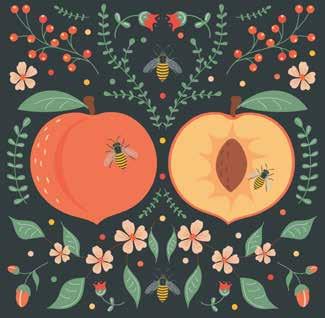

Ingredients
• 1/2 cup (125 mL) sodium-reduced chicken broth
• 2 cloves Ontario garlic, crushed
• 1 tsp (5 mL) dried thyme leaves
• 1/2 tsp (2 mL) dried oregano leaves
• 1/4 tsp (1 mL) each cayenne and hot pepper sauce
• 2 cups (500 mL) cooked rice
• 1/3 cup (75 mL) diced pepperoni
• 1 Ontario sweet green pepper, diced
• 1 large Ontario field tomato, diced
• 12 oz (375 g) skinless Ontario rainbow trout fillet(s)
• 4 Ontario peaches
• 2 Ontario green onions, thinly sliced
Instructions
In large deep skillet, combine broth, garlic, thyme, oregano, cayenne and hot pepper sauce; bring to a boil over high heat.
Stir rice, pepperoni, green pepper and tomato into boiling mixture. Cover tightly and reduce heat to medium. Simmer for 3 minutes.
Cut fish into bite-size pieces. Stir into rice mixture, cover and cook for 3 minutes.
Meanwhile, peel, pit and dice 3 peaches. Slice remaining peach (unpeeled) into wedges for garnish.
Stir diced peaches, any peach juices and onions into rice mixture. Cover and continue to cook until fish is opaque, 2 to 4 minutes. Garnish with sliced peaches.

Peach, Beet and Arugula Salad Ingredients
• 3 Ontario beets, about 2-inches (5 cm) in diameter
• 1 tsp (5 mL) Dijon mustard
• 1 tsp (15 mL) Ontario honey
• 2 tbsp (25 mL) white wine vinegar
2 tbsp (25 mL)
Trim beets, keeping 1-inch (2.5 cm) stem attached; place in small pot, cover with cold water and bring to a boil; reduce heat and simmer for 15 minutes, or until almost tender. Drain and rinse under cold water. Place in ice water until cold. Peel and slice into thin wedges. Meanwhile, in small bowl, whisk together mustard, honey, vinegar and lemon juice. Slowly whisk in oil. Season with tarragon, salt and pepper.
In bowl, combine beets, shallots and 2 tbsp (25 mL) of the dressing; let stand for 10 minutes or for up to 1 hour.
Peel peaches and slice into wedges. In large salad bowl, place arugula. Add beet mixture and peaches; toss gently, tasting and adding more dressing as desired. Sprinkle with cheese and seeds.

Ingredients
• 1 pkg (180 g) curried rice mix with raisins and almonds
• 1 cup (250 mL) sliced Ontario celery
• 1/2 cup (125 mL) sliced Ontario radishes
• 1/4 cup (50 mL) finely chopped Ontario green onions
• 1-1/4 cups (300 mL) sour cream
• 1/3 cup (75 mL) mayonnaise or salad dressing
• 2 tbsp (25 mL) bottled fruit chutney
• 1-1/2 tsp (7 mL) salt
• 1 tsp (5 mL) curry powder
• 2 cups (500 mL) small cooked shrimp
• 4 medium Ontario peaches, peeled, pitted and cubed
• Ontario leaf lettuce
Instructions
Cook rice mix according to package directions; let cool. In large bowl, combine rice, celery, radishes and green onions. Combine sour cream, mayonnaise, chutney, salt and curry powder;
add to rice mixture and toss lightly. Chill 30 minutes to blend flavours. Just before serving, add shrimp and peaches; toss well. Serve on leaf lettuce.

Ingredients
• 1 pkg (200 g) almond amaretti biscuits
• 1/4 cup (50 mL) butter, melted
Topping:
• 2 pkg (each 8 oz/250 g) cream cheese, at room temperature
• 1/2 cup (125 mL) granulated sugar
• 3 Ontario eggs
• 2 tbsp (25 mL) fresh lemon juice
• 1 tsp (5 mL) almond extract
• 1/2 tsp (2 mL) vanilla
• 1/4 cup (50 mL) peach or apricot jam (without pieces)
• 2 medium Ontario peaches, peeled, halved and pitted
• 1 tbsp (15 mL) orange juice or water (optional)
Instructions
In food processor, process biscuits to make about 1-1/2 cups (375 mL) fine crumbs. In small bowl, stir crumbs with butter until well blended. Firmly press into bottom of 9-inch (2.5 L) square cake pan. Refrigerate while preparing topping.
Topping:
In large bowl, use electric mixer to beat cream cheese until smooth. Beat in sugar until well blended. Beat in eggs, one at a time, beating



well after each addition. Beat in lemon juice, almond extract and vanilla. Pour over crust. Bake in 350°F (180°C) oven until set and golden brown around edges, 35 to 45 min. Run knife around edge of cake. Refrigerate at least 2 hr. before cutting into 16 squares.
In small saucepan, melt jam over low heat. Slice peaches into wedges, placing about 2 on each square (cut to fit, if necessary). Brush peaches completely with melted jam. If jam is too thick for brushing, add orange juice.

Ingredients
• 2 pkgs (85 g each) orange or lemon flavoured gelatin
• 1 cup (250 mL) boiling water
• 4 Ontario peaches
• 3/4 cup (175 mL) pure liquid egg whites
• 1/3 cup (75 mL) granulated sugar
• 1/2 cup (125 mL) 35% Ontario whipping cream
• 20 to 25 ladyfinger cookies, about 4” (10 cm) in length
• 2 tbsp (25 mL) fresh lemon juice
Garnish: Fresh Ontario blueberries and mint
Instructions
In medium bowl, combine gelatin and water; stir until gelatin is completely dissolved. Peel, halve and pit 3 peaches. In food processor or blender, purée peaches. Add to gelatin; stirring well. Place bowl containing peach mixture over large bowl of ice water and stir constantly until mixture cools and begins to thicken.
Meanwhile, in large bowl, using electric mixer, beat egg whites until soft peaks form. Gradually beat in sugar and continue beating until stiff peaks form.
In separate medium bowl, using electric mixer, whip cream until soft peaks form. Fold into egg whites.
Remove bowl from ice water and whisk onethird of egg white-cream mixture into peach mixture. Gently fold in remaining egg whitecream mixture until well combined.
Line bottom and sides of 8-inch (20 cm) springform cake pan with ladyfingers, arranging rounded side towards pan and cutting to fit, if necessary. Carefully spoon in peach mixture. Refrigerate until firm, about 3 hours. Place on serving plate and release sides of pan. Slice and pit remaining peach; dip in lemon juice. Garnish with peach slices, blueberries and mint.








By Luke Edwards
Two Niagara groups have teamed up to ensure nagging illnesses and injuries suffered by seasonal agricultural workers in Fenwick and beyond don’t go unattended.
For several years the Welland McMaster Family Health team has provided primary healthcare services to the roughly 300 seasonal agricultural workers in the Fenwick and surrounding area. And with the help of REACH Niagara’s Telus Health Mobile Clinic, alongside the newly opened clinic space at the Fenwick Pharmacy, they’re connecting with more workers in a more suitable setting.
“I’m really thankful to be involved to help these workers who are here and working really hard for us so that we have the incredible food system that we have in Niagara,” said Lauren DeNapoli, health educator, season ag worker program coordinator for the Welland McMaster Family Health Team.
“And it’s just nice to be able to give back to them a little bit for everything they do for us almost silently behind the scenes.”
Back in 2019, the family health team began exploring ways to help the local seasonal ag worker population. While healthcare services through agencies like Quest helped support workers in Virgil and Lincoln, there weren’t many options for workers in the Fenwick area. For those workers, seeing a healthcare professional could be next to impossible, given the long

hours they work and their limited transportation options.
“So we wanted to offer healthcare clinics on Sundays that would be accessible to workers where they wouldn’t have to ask for time off and also they could access on their own,” said DeNapoli.
A 2019 pilot project in partnership with the Fenwick library proved successful. However, 2020 brought with it the upheaval of the COVID-19 pandemic, leaving the family health team unable to use the library that year or in 2021.
Fortunately, the Fenwick United Church offered up some space, which the health team used for a couple years. While grateful for the opportunity, DeNapoli said the site wasn’t ideal.

“We were using the basement space, but it wasn’t as private and professional as we really wanted it to be,” she said.
Last year they partnered with REACH, which offered up the Telus Health Mobile Clinic for some Sunday clinics at the church parking lot. REACH formed in 2019 to address gaps in healthcare services provided to people in Ontario. Now they run a wide variety of programs, from primary care to support in filling out medical forms, navigating the healthcare system, mental health support and more.
The mobile health clinic travels across the region providing an access point for people who may not have a home address or even their own ID. REACH Niagara healthcare professionals and partners can be found at food banks, homeless shelters and elsewhere.
“It gives an opportunity for people staying in a homeless shelter the opportunity to walk down the hall and seek care without an appointment or even ID or a health card,” said Joel Hannigan, REACH Niagara communications coordinator.
Access to the mobile clinic gave the family health team a more appropriate space and also support from some of the experts from REACH.
As 2025 approached, a new organization joined in. The Fenwick Pharmacy offered up newly renovated space to allow the family health team to operate their Sunday seasonal agriculture worker clinics there. DeNapoli said it was a great opportunity because many
of the local workers already use that pharmacy to fill prescriptions. But that didn’t mean they had no use for the mobile clinic. DeNapoli said Wainfleet remained an underserved area, something that had been on her team’s radar for a few years. And with the Telus clinic no longer needed to run the main clinic on Sundays, they organized a couple trips out to Wainfleet, focusing on a greenhouse there with a sizable seasonal workforce.
“In the back of my mind all these years I was thinking we need to get out to Wainfleet,” DeNapoli said.
DeNapoli uses Whatsapp to communicate with the workers and they have translation support from groups like Bridges Niagara. She can also act as an intermediary to help coordinate further imaging or diagnostic tests such as bloodwork.
It’s doubly important, DeNapoli said, because many of the workers lack access to quality healthcare back home, meaning their time in Ontario may be their only opportunity. And since they pay taxes while working here, they’re entitled to the same healthcare access as other Ontarians.
DeNapoli said they hope to continue the Wainfleet clinics in the future. She also said the local farmers have been good to work with, helping spread the word of their clinics and events.
“The farms have been supportive of us doing this,” she said.
This year they also continued their annual appreciation fair, which brings in healthcare organizations and offers locals a chance to celebrate the seasonal ag workers.
It
be the best
Stone fruits not as early as last two years, but high yields and quality expected in 2025
By Luke Edwards
The extended heat wave of July may not have been the easiest for us humans to cope with, but it’s been a welcome sight for the region’s tender fruit.
After a couple years of exceptionally early seasons for peaches, plums and other tree fruits, 2025 has reset the schedule somewhat, said Phil Tregunno, a Niagara-on-the-Lake farmer and chair of the Ontario Tender Fruit Growers.
Peaches, for instance, were just starting to come into season as the back half of July arrived. In the two years previous growers were picking peaches at record early dates, just shortly after Canada Day.
Nectarines and yellow plums were also coming in season in the second half of July.
“It’s sort of a normal year from a couple years ago, instead of the last couple years,” he said. “Last year was extremely early and the pendulum has swung a little farther to the later side now.”
While that meant consumers had to wait a little longer for local tree fruits, Tregunno said it could be worth it. The warm weather in July should make for delicious fruit.
“We’re a little on the dry side, but with the heat - although it’s not great for all of us - it really helps bring out the sweetness in peaches,” Tregunno said.
An added bonus of the season returning to a more conventional schedule is that the yields should also be quite high, Tregunno said. The early years in 2023 and 2024 meant some fruit was lost to frost damage in the spring. However, this year he said on his farm they were having to prune just about every tree, which means consumers should have no problem finding local fruit in August.
Irrigation systems for many of the Niagara fruit growers have helped offset dry conditions, while some well timed thunder showers have helped those without irrigation, he said.
“A little nighttime rain would always be nice though,” he said.
Tregunno expects the high quality and high yields should help continue the buy local trend that other earlier fruit crops have experienced in the wake of U.S. President Donald Trump’s ongoing trade war and tariff threats.
“Our business has been built on import replacement so the ‘buy local’ and ‘buy Canadian’ (movements) should really help us this year,” he said.
Support from the retailers helps, too.
“Usually when the local fruit comes on the retailers do a really good job of getting it out to everybody and treat us fairly well,” Tregunno said.
“We’ll get the retailers all full of Niagara fruit and Canadian fruit and push all that American stuff off the shelf, hopefully, and have a good year,” he said.
The Ontario Federation of Agriculture has a Home Grown campaign that raises awareness about the importance of local produce and the need to protect local farmland.

“There is nothing quite like the taste of fresh Ontario fruit – the flavour and sweet taste is a reminder of the beauty and bounty of Ontario agriculture,” said Bill Groenheide, a director with the Ontario Federation of Agriculture and the organization’s commodity liaison with the Ontario Fruit & Vegetable Growers’ Association. “We are so privileged here in Ontario to have the weather, the environment and the soil to grow such a wide range of fresh fruit. It’s also a reminder of how important it is to keep farmland for food production and other agricultural uses. There is no way to get more once it’s gone.”
Looking ahead into August Tregunno said about an inch of nighttime rain a week and some more heat would be perfect, though as a farmer he knows Mother Nature is always ready to throw a wrench in the plans.
“We never get ideal conditions,” he said with a laugh.

Date:
Saturday August 16th, 2025 12noon-2pm

By Luke Edwards
By the end of next year, tender fruit farmers in Niagara’s west end should have a better idea of what it’s going to take to develop a regional irrigation system.
A project years in the making hit a milestone recently, as the Niagara Region announced $1.8 million in funding that will allow it to move forward with more in-depth studies of a regional irrigation project. The money comes from a mix of funders, including the federal and provincial governments, the Canadian Infrastructure Bank and the Greenbelt Foundation. The Ontario Tender Fruit Growers, Grape Growers of Ontario, Niagara Greenhouse Growers, and local area municipalities are also involved.
“Everyone is very excited about this milestone, people have been talking about it for a long time,” said Sean Norman, senior planner with the region.
While under one umbrella called the Niagara Irrigation Initiative, Norman said it’s really two separate projects. The first is to create an irrigation piping system for farmers in Niagara’s west end. It’ll stretch from Beamsville to west St. Catharines below the escarpment and likely involve pipes with access points at farmers’ driveways that they can tap into.
The second is essentially undertaking priority upgrades for an existing system in Niagara-on-the-Lake, which has an open channel system that Norman said grew organically over the years.
With the $1.8 million in funding, staff will be hiring consultants to help develop more detailed designs for the latter, while undertaking feasibility, costing and preliminary design work for the west end project. The expectation is to have that work wrapped up by the end of 2026.
The push for irrigation advancements in Niagara has been in the works for years. Norman said a dry 2016 growing season rejuvenated the call for an irrigation project. Industry leaders, local politicians and municipal planners have been working on the project since.
“The Niagara Irrigation Initiative is essential for supporting agriculture in Lincoln and across our region, and Lincoln has led its progress from the outset,” said Lincoln Mayor Sandra Easton. “Thanks to strong collaboration and investments from all levels of government and industry partners, we’re building modern irrigation infrastructure to address climate change, protect livelihoods, and keep our farmland thriving. Together, we are making Lincoln and Niagara stronger, more resilient, and future ready.”
Norman said there was some consideration to creating a single, unified system, but with urban St. Catharines sitting between the two key agriculture areas, maintaining

two separate systems seemed like a better way to go.
With increasingly warm temperatures and more extreme weather events - including drought conditions - Norman said the need for irrigation for the region’s farmers isn’t going away. However, a project of this magnitude will be costly and require financial support from multiple levels of government along with the local farming community.
“Everyone’s eager to see what the costs would be, and that’s one of the big reasons we’re doing this, so we can have a realistic idea of what it would cost,” Norman said.
And with it being such a large project, Norman said phasing will have to be considered. Coordinating with other major infrastructure projects, especially to cross the QEW, will also be part of the planning.
David Hipple is a tender fruit farmer in Beamsville and chair
of the Niagara Irrigation Initiative Project Steering Committee. The eight-generation Niagara farmers said the project is an investment for the future.
“I’m thrilled to see this vital investment in the Niagara Irrigation Project. New and improved irrigation systems aren’t just about efficiency; it’s about protecting livelihoods, supporting food security, and ensuring that future generations can continue to farm this land.” he said.
Officials held some public engagement sessions late last month and Norman said they will continue to seek input from the local farming community throughout the process.
“Over the course of the study there will be numerous points where we’re reaching out,” he said. “We expect a pretty significant consultation program over the next 18 months.”
Please join us in welcoming James Crompton, a new member of 4-H!
James has joined the Niagara Poultry Club as his very first club, and he’s already showing an impressive amount of knowledge and enthusiasm.
Full of energy and potential, James holds great promise for his future 4-H showing seasons. We’re excited to see what he’ll accomplish and how he’ll grow within the program.
James’s questions:
1. Are you excited to learn how to take care of poultry?
A: Yes, I have learned how to identify the body parts of a chicken.
2. Have you been in 4-H before, or would this be your first time?
A: This is my first time being in 4-H
3. Do you want to show your bird at the fair?
A: Yes, the Wainfleet fair is where I first learned about 4-H
4. What’s your favorite thing about the club?
A: I think we get to do a bake off at our next meeting!



NOTL PEACH FESTIVAL
AUGUST 8 & 9
WINONA PEACH FESTIVAL AUGUST 22 - 24

SATURDAY, AUG. 10 4 P.M.

WEDNESDAY, AUG. 13 5:30 P.M.


SATURDAY, AUG. 30MONDAY, AUG. 31
10 A.M. - 5 P.M. THROUGHOUT SEPTEMBER


By Luke Edwards
When it’s a race to the bottom, it’s pretty difficult to move up.
That’s the lesson Bill Redelmeier learned many years ago as he grew up on the family farm in Richmond Hill and branched out on his own. Now, with all that experience under his belt, and a successful winery in Niagara that is at the forefront of marrying quality with respect for the planet, Redelmeier is using Southbrook’s clout to promote the great things going on elsewhere in Niagara’s food and farm sector.
Earlier this summer the winery released Ode to Niagara, a mini documentary that not only promotes Niagara’s terroir and penchant for producing great wines, but also showcases other businesses like King Street Pantry and Always June Organic Farm. The video is part of Southbrook’s effort to partner with like-minded farm and food producers to get people thinking about local food grown right and comes as they celebrate 20 years since the purchase of the vineyard.
The documentary is a natural companion to Southbrook’s new Sunday farm market.
“We’re trying to build a network of farmers who share our values,” Redelmeier said.
This isn’t the first time Redelmeier has made this push. He grew up on a dairy farm in Richmond Hill, Canada’s largest Jersey operation.
“I wasn’t particularly happy with dairy farming and I wasn’t sure why,” he recalled.
As he and his siblings got older, the farm evolved. Redelmeier did some cash cropping and was looking for something else. So they opened a farm market.
What he learned was that a business like that that’s based primarily on price is doomed to fail. As soon as someone lowers their price everyone else is forced to react.
“And then it’s a race to the bottom,” Redelmeier said.
So he decided to base his business on something else. And that something was plural.
“We based it on quality, and qualities,” he said.
That meant local and it meant farmers who shared Redelmeier’s values.
So what are those values? A sign in front of Southbrook’s main entrance offers some clues. It includes 23 different ways Southbrook is reducing its impact on the environment, starting with being certified organic, biodynamic and sustainable, to more specific actions like its solar field, bioswales and conservation areas to promote bee and pollinator health.
Consumer awareness of some of these efforts have improved in recent years, Redelmeier said, but it’s still an uphill battle. So why continue to push?
“Sometime I like to be ornery,” he said, with a slight laugh.
“But if we don’t do it, nobody will.”
The winery was born in 1991, with Redelmeier sourcing his grapes from Niagara. By the early 2000s it became apparent to him that they needed land in Niagara.


“We needed to have more control of the grape growing process,” he said. By late 2007 the wine shop’s move to Niagara-on-the-Lake was underway.
Now, with years of experience, Redelmeier said he and the Southbrook team are happy to share their knowledge with other farmers who share their values but are maybe smaller or just starting out. The market helps do that.
But to make a go of it, Redelmeier said it’s all about adding value and not falling into a familiar trap where farmers aren’t distinguishing their product.
“Too many think that if they get their crop to the end of the driveway, God will take it away,” he said.
That’s where Southbrook’s focus on quality and qualities comes in.
He also encourages growers to find ways to extend the life of their product, turning older strawberries into jam that lasts months, or drying and grinding dated mushrooms to make a seasoning powder.
The idea for the mini-documentary first came up last year. At the time, Redelmeier said they didn’t realize what was ahead of them and the renewed vigour to support local in the face of trade wars and annexation threats from a new U.S. president.
However, its release has happened to coincide with a newfound Canadian agri-patriotism. Either way, Redelmeier’s happy to see more people interested in buying local.
Continued from page A26
“We’re trying to get people back to thinking about where their food comes from,” he said.
“Local is really important. Without farmers, we’re screwed.”
To celebrate the mini-documentary, the winery held a premiere event that included a Q-and-A with chef Keith Pears last month. It occurred alongside one of the winery’s Sunday markets.
The market is part of Southbrook’s Summer of Sustainability series. It runs Sundays from 11 a.m. to 3 p.m. Other events include Wednesday night socials, organic wine tastings, and daily free self-guided tours of the winery.
For more information on Southbrook’s events or to sign up for its newsletter, visit southbrook.com. The mini-documentary can also be viewed on Southbrook’s YouTube channel.
















